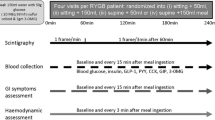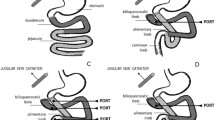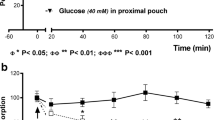Abstract
Feeding produces a sustained increase in lower esophageal sphincter pressure (LESP) that is impeded by vagolytic blockade with atropine. This study determines the effect of varying levels of vagotomy on postprandial LESP and hormones known to stimulate LESP. Six dogs had measurement of fasting and postprandial LESP at 15-min intervals after a 60 g beef meal. Blood was drawn for gastrin and pancreatic polypeptide (PP). The animals then had proximal gastric vagotomy (PGV) and subsequently, truncal vagotomy and pyloroplasty (TVP). The studies were repeated after recovery. Feeding produced a marked increase in LESP during the control period (p < 0.001) that was not affected by PGV (p > 0.6). In contrast, TVP completely abolished the LES response to feeding (difference from controls and PGV significant atp < 0.01). Gastrin response to feeding was accentuated by PGV, but this response normalized after TVP. Pancreatic polypeptide increased postprandially during the control period (p < 0.001). These increases were not affected by PGV (p > 0.6), but were completely abolished by TVP (difference:p < 0.001). Truncal vagotomy abolishes the postprandial rise in both LESP and pancreatic polypeptide. This suggests that vagal influences may play a role in the normal postprandial rise in LESP, possibly by release of pancreatic polypeptide, a hormone known to increase LESP.
Résumé
La nourriture produit une augmentation prolongée de la pression du sphincter oesophagien inférieur qui est bloquée par les agents vagolytiques tels que l'atropine. Cette étude a pour objet de déterminer les effets des différents types de vagotomie sur la pression sphinctérienne post-prandiale et des hormones susceptibles de la stimuler. Chez 6 chiens la pression sphinctérienne post-prandiale a été mesurée toutes les 15 minutes après un repas constitué par 60 g de viande de boeuf. Des échantillons sanguins ont été prelevés pour doser la gastrine et l'hormone PP (polypeptide pancréatique). Les animaux subirent une vagotomie hypersélective puis postérieurement une vagotomie tronculaire avec pyloroplastie. Les études furent répétées après ces interventions. La prise d'aliments provoqua une élévation marquée de la pression sphinctérienne pendant la période de contrôle (p <0.001) élévation qui ne fut pas affectée par la vagotomie gastrique proximale (p>0.6). En revanche la vagotomie tronculaire entraîna l'abolition complète de la pression sphinctérienne après l'alimentation. Le taux de gastrine secondaire à la prise d'aliments s'éleva après vagotomie hypersélective mais il redevint normal après vagotomie tronculaire. Le taux de la PP s'éleva en post-prandial pendant la période de contrôle (p<0.001). Cette augmentation ne fut pas affectée par la vagotomie hypersélective (p>0.6) mais disparu totalement après vagotomie tronculaire (différence:p<0.001). La vagatomie tronculaire entraîne la disparition de l'augmentation de la pression sphinctérienne et de la PP lors de la phase postprandiale. Ceci suggère que le vague peut jouer un rôle dans l'élévation post-prandiale de la pression du sphincter oesophagien inférieur par l'intermédiaire d'une décharge de PP, hormone connue pour augmenter la pression sphinctérienne.
Resumen
La ingesta del alimento proteico resulta en una sostenida elevación de la presión del esfínter esofágico inferior (PEEI), la cual puede ser bloqueada por el efecto vagolítico de la atropina. El presente estudio tuvo por objeto determinar el efecto de diversos niveles de vagotomía sobre la PEEI y sobre las hormonas que son capaces de estimular la PEEI. En 6 perros se realizó la medición de la PEEI, en ayunas y postprandial, a intervalos de 15 minutos después de una comida de 60 g de carne. Se tomó sangre para determinación de gastrina y de polipéptido pancreático (PP). Los animales fueron entonces sometidos a una vagotomía gástrica proximal (VGP) y, más tarde, una vagotomía troncular y píloroplastia (VTP). Los mismos estudios fueron realizados en cuanto el animal se hubo recuperado. La ingesta del alimento produjo un marcado aumento en la PEEI durante el período de control (p<0.001), el cual no se vió afectado por la VGP (p>0.6). En contraste con lo anterior, la VTP abolió totalmente la respuesta del EEI al alimento (diferencia significativa con controles y VGP ap<0.01). La respuesta de gastrina al alimento apareció acentuada por la VGP, pero esta respuesta se encontró normalizada después de la VTP. El PP aumentó postprandialmente en el perîodo de control (p<0.001). Este aumento no se vió afectado por la VGP (p>0.6), pero resultó totalmente abolido por la VTP (diferencia:p<0.001) La vagotomía troncular bloquea el aumento tanto de la PEEI como del PP. Esto sugiere que la influencia vagal puede jugar un papel relevante en el aumento postprandial normal de la PEEI, posiblemente mediante la liberación de PP, una hormona que, se sabe, aumenta la PEEI.
Similar content being viewed by others
References
Nebel, O.T., Castell, D.O.: Lower esophageal sphincter pressure changes after food ingestion. Gastroenterology63:778, 1972
Maher, J.W., Crandall, V., Woodward, E.R.: Effects of cholinergic blockade on postprandial and acidstimulated lower esophageal sphincter pressure. Am. Surg.44:758, 1978
Lipshutz, W., Hughes, W., Cohen, S.: The genesis of lower esophageal sphincter pressure; its identification through the use of gastrin antiserum. J. Clin. Invest.51:522, 1972
Maher, J.W., Olinde, A.J., McGuigan, J.E.: Suppression of postprandial lower esophageal sphincter pressure and pancreatic polypeptide by duodenal exclusion. J. Surg. Res.37:467, 1984
McGuigan, J.E., Wolfe, M.M.: Gastrin radioimmunoassay. Clin. Chem.28:368, 1982
Chance, R.E., Moon, N.E., Johnson, M.G.: Human pancreatic polypeptide (HPP) and bovine pancreatic polypeptide (BPP). In Methods of Hormone Radioimmunoassay, B.M. Jaffe, H.R. Behlman, editors. New York, Academic Press, 1979, pp. 657–672
Maher, J.W., Hollenbeck, J.I., Sierakowski, N., Woodward, E.R., McGuigan, J.E.: Effects of bicarbonate perfusion on lower esophageal sphincter response to feeding. Surg. Forum26:366, 1975
Dodds, W.J., Hogan, W.J., Miller, W.N., Arndorfer, R.C., Barreras, R.F.: Relationship between serum gastrin levels and lower esophageal sphincter pressure in fasting subjects. Gastroenterology66:686, 1974
Morris, D.W., Schoen, H., Brooks, F.P., Cohen, S.: Relationship of serum gastrin and lower esophageal sphincter pressure in normals and patients with antrectomy. Gastroenterology66:750, 1974
Gonella, J., Neil, J.P., Roman, C.: Vagal control of lower esophageal sphincter motility in the cat. J. Physiol. (Lond.)273:647, 1977
Jacobowitz, D., Nemir, P.: The autonomic innervation of the esophagus of the dog. J. Thorac. Cardiovasc. Surg.58:678, 1969
Soon-Shiong, P., Debas, H.T.: Fundic inhibition of acid secretion and gastrin release in the dog. Gastroenterology79:867, 1980
Coltharp, W., Maher, M., Maher, J.W., Khoury, A.M., McGuigan, J.E.: The effect of vagotomy on lower esophageal sphincter pressure response to pancreatic polypeptide. Surg. Forum.36:119, 1985
Author information
Authors and Affiliations
Rights and permissions
About this article
Cite this article
Olinde, A.J., Maher, J.W. & McGuigan, J.E. The effect of varying levels of vagotomy on postprandial lower esophageal sphincter pressure and pancreatic polypeptide. World J. Surg. 10, 809–813 (1986). https://doi.org/10.1007/BF01655246
Issue Date:
DOI: https://doi.org/10.1007/BF01655246




